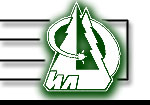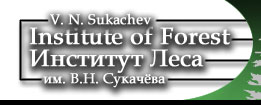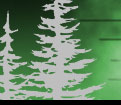 |
 |
 |
||
V. N. Sukachev Institute of Forest Siberian Branch of the Russian Academy of Sciences
Institute of Forest SB RAS is the first academic institution of forest profile in this
country. It was founded in 1944 in Moscow by an outstanding native biologist academician Vladimir Nikolayevich Sukachev. The institute
was named after him in 1967. In 1959 the Institute was joined in Siberian Branch of Academy of Sciences of the USSR and transferred to
Krasnoyarsk.
In various years the Institute was headed by academicians V.N.Sukachev (1944-1959),
A.B.Zhukov (1959-1977), A.S.Isayev (1977-1988). Since 1994 the Institute has been headed by academician Y.A.Vaganov. Institute of
Forest SB RAS is the largest forest-biologic institution in Russian Academy of Sciences. Its staff
consists of 170 scientific researchers, 1 academician, 33 doctors and 95 candidates of sciences including. Among them there are
3 Honoured scientists of RF and 4 Honoured foresters of RF. More than 60 people ate taking Ph.D.course simultaneously in a number of
forest specialities: forest science, forestry, forest management, forest taxation, sylvicultures, forest pyrology, genetics and
selection, ecology, botany, forest soil science, entomology, microbiology, phisiology and biochemistry of wood plants, bioinformatics.
From 1947 to 2003 at the Institute 140 prominent native foresters have defended their doctor’s theses. A part of them were
then elected members of Academy of Sciences.
Since 1947 the Institute has been a collective member of International union of forest
research institutions, since 1991 it has entered International association of boreal forests researchers.
The library of the Institute is a depository of scientific literature on forest themes
for regions of Siberia and Far East. It makes up more than 150 units of storage. The readers of the library (550 people) are not only
employees of the institute but also lecturers, Ph.D. students and university students.
The structure of the Institute (4 departments, 10 laboratories and a branch in
Novosibirsk) provides development of fundamental and applied research in a wide range: biospherical role, ecologic functions and
biodiversity of forest ecosystems, monitoring of their condition, rational usage of forest resources.
The scientific schools formed at the Institute: taiga forestry and productivity of
forests, permafrost forestry, taxation and forest exploitation, forest morphology, cartography, aerospace information usage, forest
genetics and selection, pyrology, zoology, microbiology, physiology and biochemistry of wood plants, dendrology and dendroclimatology
and other spheres of forest biological science are the basis for mutual investigations with the scientists of the USA, Canada,
England, Germany, Italy, Switzerland, Belorussia, Sweden, Norway, Finland, Japan, China, Korea, Mongolia. In 1992 there has been
founded Siberian international center of ecological investigations of boreal forests which favours the participation of employees in
foreign grants, projects, programs including the problems of climate changes, atmosphere gas composition and biodiversity.
In different landscape-ecological conditions on the territory of Siberia a net of
basic research points (stationaries) to carry out experimental work and durable monitoring of forest ecosystems function was created.
Availability of experts of various profiles at the Institute makes it possible to
estimate scientific and applied forest problems. So, in the 1960s a complex research of mountain Siberian pine forests of Siberia was
finished by development of “Instructions” on forest management in them. In
it for the first time the primary significance of forestforming functions of this forest formation and their hydrology role in
particular was stressed.
In the activities of the Institute a great place is taken by investigations in the
forests of lake Baikal started on the initiative of academician A.B.Zhukov yet in early 1970s. The developed approaches regulate
exploitation of the region forests. They scientifically ground monitoring of forest exploitation. It is proved by regional evaluation
scale of reforestation evaluation, by landscape approach to location of wood-cutting areas and by rating of technogenic load on the
ground. This provides the level of ecological security corresponding to legislation of RF on lake Baikal protection and UNESCO
requirements to the objects of World heritage.
For a number of years the Institute has been developing application methods of
information coming from flying vehicles (planes, satellites) to estimate condition of forest cover of taiga zone under the impact of
anthropogenic and natural factors. Under the leadership of academician A.S.Isayev in 1970-1980 there was worked out a system of
aerospace information analysis. It includes etalon polygons on which on-ground and remote information was compared. Forest territories
were differentiation on natural basis, experimental research of interaction of electromagnetic radiations with typical forest
vegetation was made. Real expression of these investigations became a thematic cartography of resourcefully perspective single
regions, compilation of forest fund maps.
Continuation of this work nowadays is development of technique of woodstands taxation
and morphology structure investigation on the basis of laser, digital photo and video survey, digital satellite survey and
three-dimensional taxational computer analysis of images. On its basis regularities of taxational structure and dynamics of phytomass
in plantations forming after fires and cuttings were found out.
Two receiving and analyzing satellite information stations available at the Institute
make it possible to estimate ecological information in real time in the interests of various institutions.
In cooperation with foreign scientists the Institutes is working out the system
approach to forest management with the help of GIS technologies and databases characterizing the main components of forest
biothenoses.
On the basis of modern techniques of receiving and analysis of scientific information
estimation of ecological condition of forests in the zones of huge technogenic impact (oil-gas complex of West Siberia, Norilsk
industrial region) is carried out.
In two dendrariums of the Institute for more than 30 years about 450 species,
subspecies and forms of trees and bushes from different botanico-geographical regions have been investigated. Their acclimatization,
growth and development in new conditions are estimated to select perspective species for planting of greenary in towns and other
settlements. Long-term investigations of siberian forests are reflected in more than 450 books and collections of papers of the Institute employees. The information about features of forest forming process contained in them is widely used by home and foreign scientists and design organizations. On its basis normative documents (rules, directions, recomendations) regulating the main forest production works in Siberia.
|